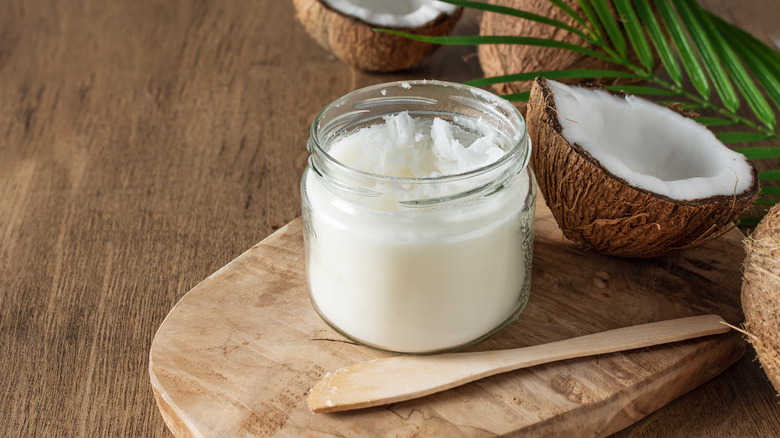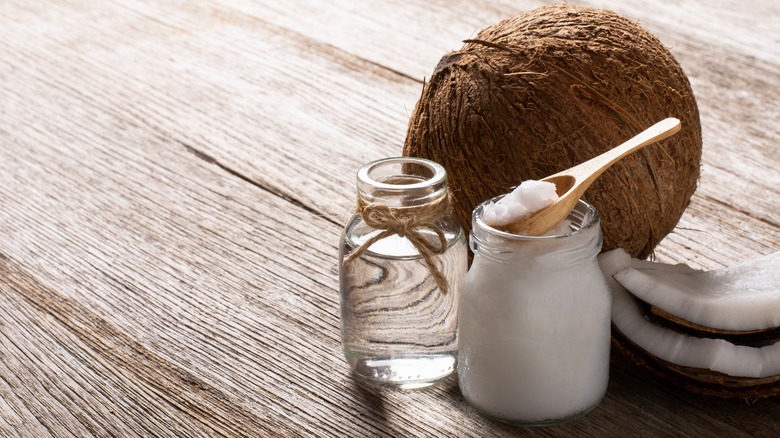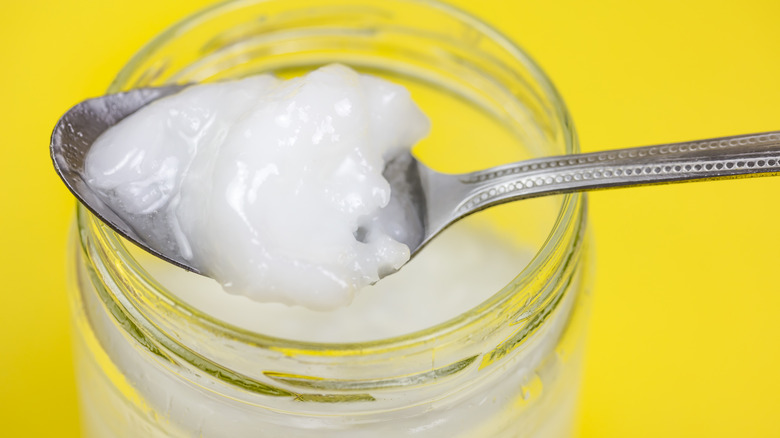Should You Store Coconut Oil In The Fridge Or Pantry?
Whether you reach for coconut oil to make grilled cheese crispy without mayo or to slather it on your face as a moisturizer, it is a handy ingredient to have on, well, hand. However you're using coconut oil, you may have wondered where it's best to store it. Coconut oil is shelf-stable, and can reside in either the fridge or pantry. When to choose which spot mostly comes down to how you plan on using the oil, and how fast.
A jar will be stay fresh in the pantry even after it's opened, but you can extend its lifespan a bit by storing it in the fridge. Light, heat, and air can all cause oxidation and speed up spoilage. A dark, cold fridge will probably offer more protection from these factors than a cabinet in the kitchen will. If it takes you a while to get through a whole jar, it is probably wise to stick it in the fridge.
However, if you use it often and go through it quickly, its form will come into play. Coconut oil is a saturated fat, which is solid when cold, liquid when warmed, and soft at room temperature (think of a stick of butter: soft on the countertop, and hard in the fridge). If you like it softer, pop it in the pantry. If you prefer it solid and closer to that hardened stick of butter, into the fridge it should go. Coconut oil will liquefy at about 78 degrees Fahrenheit.
Refinement affects shelf life
The shelf life of your jar will vary based on the level of refinement of the oil. Unrefined coconut oil, also known as virgin or extra-virgin, can last up to three years. Refined coconut oil has a shorter shelf life, lasting up to a year and a half. Unrefined coconut oil is made by pressing fresh coconut meat to extract the oil, whereas refined coconut oil is made from dried meat, known as copra. It is also degummed, bleached, and deodorized in the refinement process. Both refined and unrefined are great cooking oils to try, but keep their type and subsequent shelf life in mind when choosing the best spot to store them.
Regardless of its refinement and where you plan to store your oil, there are some measures you can take to keep it fresh as long as possible. Always use a clean spoon or utensil. Food remnants, including drops of water, can cause cross-contamination and promote mold. Also ensure the jar is always closed tightly. Any moisture entering will lead to mold and bacteria. And if you prefer it in a soft or liquid state and choose not to opt for the fridge, keep in mind that while that rack above or spot right next to your stove may be enticing for being within arm's reach, the heat emitted by the oven and burners may speed up spoilage. You also want to keep it out of direct sunlight, so a closed cabinet is best.
How to tell if coconut oil has gone bad
While all coconut oil does have a pretty long shelf life, it is perishable and can and will go rancid and spoil at some point, even if you aren't making any obvious food storage mistakes. Always check your coconut oil's expiration date if you haven't used it in a while. Your five senses are also a handy tool for detecting any spoilage.
When it comes to color, coconut oil is white when solid and clear when liquid. If it starts to take on a yellow hue or you see any spots of black or green, it should be tossed. It's sometimes normal for unrefined coconut oil to be faintly tinged yellow when solid, but if it's a brighter shade when in a liquid state, it is spoiled. Cloudiness, visible particles in it, or if it looks thick or chunky or has any other changes in texture, are all indicators that it's better to be safe than sorry.
Any off or sour smells are also signs of rancidity. Unrefined coconut oil will have more of a coconut-y scent, while refined's aroma is more neutral. If you smell anything else, it is likely spoiled. And if it tastes like anything other than the coconut oil you know and love and have been using, into the garbage can it goes. Unrefined coconut oil will have more of a coconut-like flavor than refined, but there should be no change to its taste over time.



